

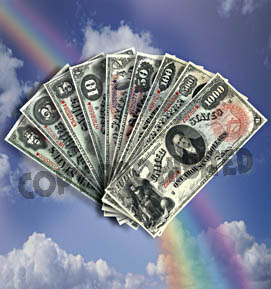
In 1869, all legal tender issues from the $1 to $1,000 denominations were printed on special paper that had a vertical segment of blue color on the obverse interspersed with a large number of silk fibers to deter counterfeiting. The combination of this paper with the red serial numbers, Treasury Seal, and the black main design gave rise to the term “rainbow note.”
LEFT: The Only Complete Set of Rainbow Notes Outside of the U.S. Government Collection
RIGHT: After five centuries, Columbus remains as one of the greatest mariners in history, a visionary genius, a national hero, a failed administrator, a naive entrepreneur, and a ruthless and greedy imperialist. He settled for a time in Portugal, where he tried unsuccessfully to enlist support for his project, before moving to Spain. After many difficulties, through a combination of good luck and persuasiveness, he gained the support of the Catholic monarchs, Isabel and Ferdinand.
The illustration on the right is from the engraving on the left side of
the one dollar rainbow note shown below.

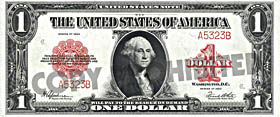
ABOVE:
This was the last large size legal tender
note issued before
the change to the current small size notes. The portrait of George
Washington is the same one used on current one-dollar notes.
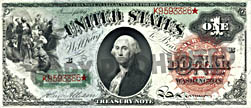
ABOVE:
THE
ONE DOLLAR "RAINBOW" NOTE
Series 1869 Series 1869
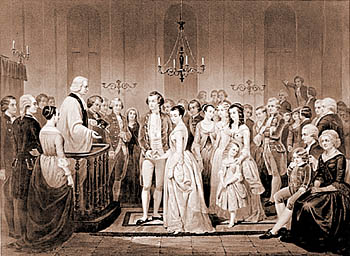 A
A
George
and Martha Washington at their wedding ceremony.
A young George Washington at the time of his marriage was a soldier during
the French and Indian wars.
Engraved by John Rogers after C.W. Peale, from Prints
and Photographs Division, Library of Congress

This original check was written and signed by George Washington at Mount Vernon on January 21, 1799. It was made payable to Major Watts for $111.04.
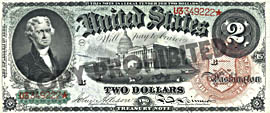
ABOVE:
Two Dollar “Rainbow” Note
Portrait of Thomas Jefferson, third President of the United States, 1801-1805
BELOW:
JEFFERSON
WRITES TO MATTHEW CAREY AS EX-PRESIDENT JUNE 30, CIRCA 1811-1822
After serving two terms as President, Jefferson retired at his home, Monticello,
which he designed and began building in 1770.
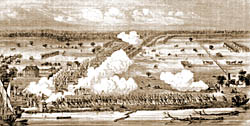
RIGHT: Soldiers who served in the War of 1812 were granted as a pension 120 acres of Federal Land. This original certificate is exceedingly rare because they were turned in to the government to claim the land.
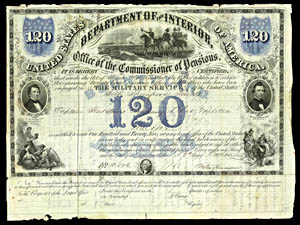
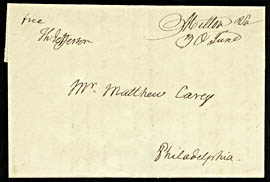
BELOW:
Free frank signed by James Madison
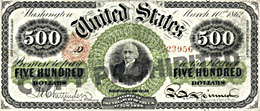
ABOVE: The above note is unique and is even missing from the U. S. Government collection. It is the first issue of $500 legal tender notes and was discovered in the Oat Bin Hoard. The portrait is Albert Gallatin, an early American Statesman born in Switzerland in 1761.
UPPER RIGHT: Dr. Carter received a call from a fellow banker in 1966 about a cash hoard that had just been brought in to the bank. “Some of the notes were very old if indeed real and some had a smell to them,” were the closing remarks of that conversation, I was told. I’m sure Dr. Carter was as amazed as many of us who later looked at the notes that were in this accumulation of old “horse blanket” bills. “Where did you find this stuff?” The banker related that last week one of the men they had hired to clean up the farmstead of an estate they were settling had brought this money in. The two men brought the money to the banker with the explanation, “Look what we found in that old oat bin at the farm.”It was full of what looked like rolls of paper, but it was U.S. paper money, some over one hundred years old. THE OAT BIN HOARD HAD BEEN DISCOVERED.
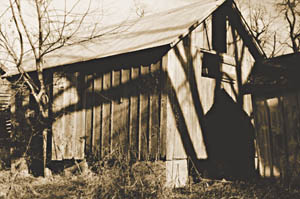
The building on the farm where the “Oat
Bin Hoard” was discovered in 1966. It has since been torn down.

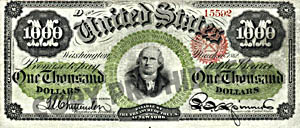
ABOVE: This banknote is also unique and was discovered in the Oat bin hoard. Although it is dated 1863, it has a script date of 1862.